

Ask Before You App. SOPIPA Guide Nov 4 2016. Internet Safety 101: Internet Safety. Listen The Internet can be a wonderful resource for kids.
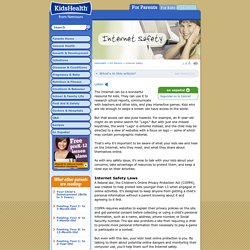
They can use it to research school reports, communicate with teachers and other kids, and play interactive games. Kids who are old enough to swipe a screen can have access to the world. But that access can also pose hazards. Technology Contract Checklist w Sample AB 1584 Contract Addendum. PhD Model Exams Sample Questions. Children’s Online Privacy Protection Rule: A Six-Step Compliance Plan for Your Business. When it comes to the collection of personal information from children under 13, the Children’s Online Privacy Protection Act (COPPA) puts parents in control.
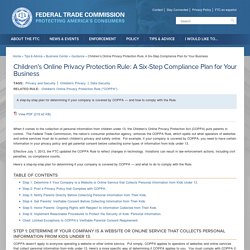
The Federal Trade Commission, the nation’s consumer protection agency, enforces the COPPA Rule, which spells out what operators of websites and online services must do to protect children’s privacy and safety online. For example, if your company is covered by COPPA, you need to have certain information in your privacy policy and get parental consent before collecting some types of information from kids under 13. Effective July 1, 2013, the FTC updated the COPPA Rule to reflect changes in technology.
Violations can result in law enforcement actions, including civil penalties, so compliance counts. How Student Privacy and California’s SOPIPA May Affect You. Answering Essay Questions in Comprehensive Exams - CEBS - WKU. Comprehensive Exams Read the question twice.
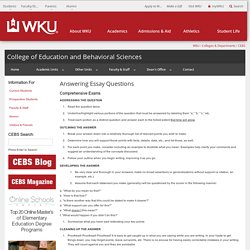
Underline/highlight various portions of the question that must be answered by labeling them “a,” “b,” “c,” etc. Treat each portion as a distinct question and answer each to the fullest extent that time will allow. Break your answer down into a relatively thorough list of relevant points you wish to make. Determine how you will support those points with facts, details, data, etc., and list those, as well. Be very clear and thorough in your answers; make no broad assertions or generalizations without support (a citation, an example, etc.). A. Summarize what you have said reiterating your key points. Csm privacy report interactive 070215 proof 3. Position Statement - Student Data Privacy and Security - About PTA. Csm privacy report interactive 070215 proof 3.
E-Safety Task Force. On September 21, 2015, the Ventura County Office of Education (VCOE) hosted an iKeepSafe workshop, Got Student Data Privacy Concerns?

What the Experts Are Saying! While attendees heard from a variety of experts including Marsali Hancock, President and CEO of iKeepSafe, the Berkman Center for Internet and Society at Harvard University, and Data Quality Campaign, it became apparent that more learning opportunities and support for districts were needed not only to ensure compliance, but to foster a safe and healthy digital learning environment for all stakeholders.
To answer this need VCOE, together with its districts and some in nearby counties, is forming an e-Safety Task Force. Supported by iKeepSafe and Fagen, Friedman and Fulfrost, the goal is to share a replicable e-Safety Committee model for any interested district. This site is intended to be a dynamic collaborative documentation of our work. Members - e-Safety Task Force. Thank you to our committee members: Briggs Elementary School District Sam Pacheco, Principal, Briggs Schools Carpenteria Unified School District Gerardo Cornejo, Principal, Carpenteria High School Charter Schools in Ventura County Conejo Valley Unified School District Fillmore Unified School District Amber Henrey, Coordinator of Curriculum, Assessment, and TechnologyAnthony Ibara, Director of Technology.

More About the Agreements Types. Privacy Policy in Mobile Apps - Why and How. According to a study made in June of 2012 only a 48% of all free apps and a 32% of paid apps across App Stores (Apple, Android, Kindle) offered in-app access to a privacy policy.
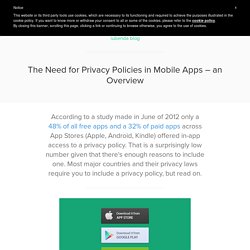
That is a surprisingly low number given that there's enough reasons to include one. Most major countries and their privacy laws require you to include a privacy policy, but read on. The Attorney General of California made it clear that its Online Privacy Protection Act would be enforced on apps (CalOPPA). To make sure these laws were actually being followed California's Department of Justice set up a Privacy Enforcement and Protection Unit in July of 2012. This may sound like it's only valid for developers based in California, but it's actually a call for compliance for anyone possibly targeting Californians. State Student Privacy Policy. Introduction The Family Educational Rights and Privacy Act of 1974 (FERPA) establishes baseline privacy protection for educational records.
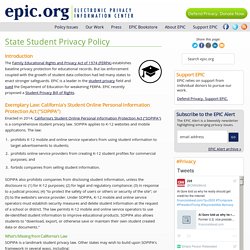
But lax enforcement coupled with the growth of student data collection had led many states to enact stronger safeguards. Data Privacy - Data & Statistics. Privacy of Student Records Collected and Maintained by the California Department of Education Statutory Authority.
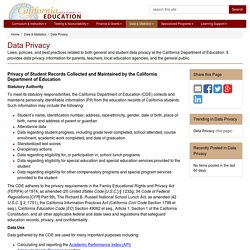
Welcome. CSDPA Final V1 Overview. Ambitious Student-Data-Privacy Law in California Attracts National Attention. How To Protect Your Privacy As An Online Student. – EDTECH 4 BEGINNERS. Technology has always been a driving force of change.
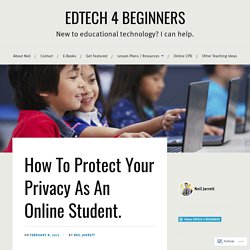
It has radically transformed education. Students have the convenience and flexibility to study online. However, online education has also created a host of new challenges. 2012 31341. A tech perspective... or something like that. ***Update*** I am re-posting this as part of the #EdublogsClub week 8 prompt.

Products Archive - iKeepSafe. F3Law. Six Strategies for Sailing through Comprehensive Exams - phdsisters. ~by Amina Abdullah-Winstead, PhD Author/Founder (IPSA) 1. Follow the Comprehensive Exam Manual As learners, we naturally have questions and concerns about taking any exam let alone the “dreaded” comprehensive exam! However, schools offering a doctoral program want to see you pass the exam and move into the dissertation phase of your program. They are not out to get you.J With this in mind, many colleges and universities provide an instructional guide to follow for the comprehensive exam process. 2. At this point in your program, you should have a fresh recollection of Bloom'sTaxonomy from writing assignments in your research classes. 3.
Read your exam questions. 4. There are typically set time limits associated with the completion of your comprehensive exam. 5. Proofreading and editing your work are important components of the exam process. 6.